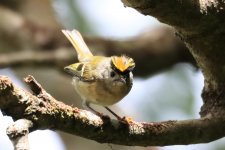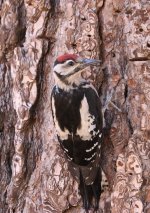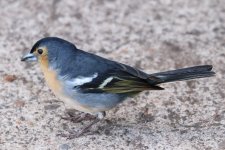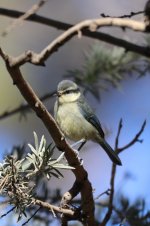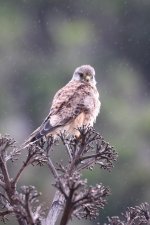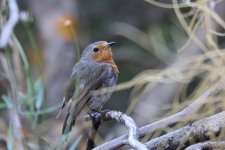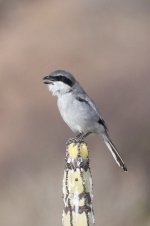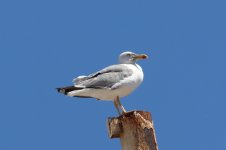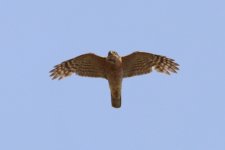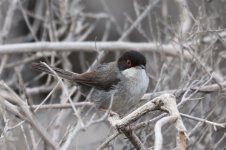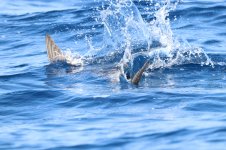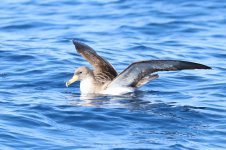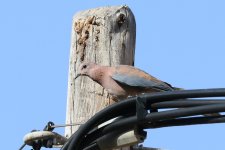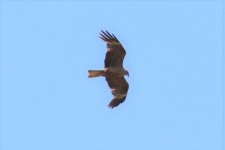Hi All, let me a share a summary of my birding experience on Tenerife for several weeks in July 2022.
Birding was not the main purpose of my trip, rather I wanted to take my wife and our parents and let them have a break from some of the difficulties we are facing back home. So I was mostly working and trying to spend as much time with my family as I could, but I also took care to devote a certain amount of time to birding and made sure I visited some of the key birding locations at least once (and some of them – more than once ).
).
Birding trip reports written by other birders were immensely helpful for my preparation, as were many observations I found on ebird – I am very grateful to all people who contributed to that.
My initial goal was to see all endemic species plus the Barbary Falcon, but after that turned out to be all too easy (well, easy except for the Barolo shearwater, of course), I expanded my goal and attempted to see and photograph all subspecies endemic to the Macaronesian region that you can spot on Tenerife. Well, that proved to be quite a challenge and I did fall short of that target, but not by much
I will not be writing a detailed report describing each birding search I performed – instead I will just provide a summary of all species I attempted to see (which, again, was all endemic species and subspecies, both restricted to the Canary Islands and to the Macaronesian region as well). I will make comments on each species/subspecies, which I hope might be useful for future explorers. I also attach pictures of all birds that I observed.
Last comments before I start: 1. Taxonomy of this report follows IOC, and 2. I was birding on Tenerife only.
Endemic Species - Canary Islands only
Tenerife Blue Chaffinch – not much to add here to what is mentioned in the other reports. On my first birding trip on Tenerife I went to Las Lajas, and these birds were quite common and approachable there. I did not see Blue Chaffinches anywhere else on the island, but, then again, I was not specifically looking for them after Las Lajas.
Canary Islands Chiffchaff – it is everywhere. Literally everywhere. You could be heading down for breakfast and the Chiffchaff could greet you in the lobby as you exit the elevator
Laurel Pigeon – I saw one bird on my very first arrival to the laurel forest in Erjos, and then saw at least several birds each time I went to explore a different spot on Barranco de Ruiz. I would say this Barranco is very good location for this endemic pigeon.
Bolle’s Pigeon – the more difficult of the two endemic pigeons (in my opinion, at least). I only saw it in two locations and the second one, in the Anago park, was just a chance encounter when I observed the bird for maybe 2 seconds. Luckily, there is a very reliable location for this endemic pigeon, and it is located right at the start of the Erjos forest track. The pigeons love to congregate on several conspicuous bare trees not far from the place where you enter the laurel forest. This is the location where you need to stand - 28.3294,-16.8102. You should have no difficulty locating them there, but if you do – consider hiking 100-200 meters up the Sendero Monte del Aqua trail; this will chase the pigeons back to the valley, then you may return and observe/photograph them from the indicated location.
Endemic Species – Macaronesian Region
Atlantic Canary – relatively common, especially as you head outside the city/village you are staying in. The biggest numbers I probably saw at Barranco de Ruiz and at Las Lajas.
Plain Swift – provided you have mastered the key distinguishing features (small size, rapid wingbeats, erratic flight, sometimes flying between the trees), picking out these swifts should not be a problem. Once you have taken a picture, you should also recognize the small/barely noticeable throat patch and the deeply forked tail. I found them very common in such resort places as Callao Salvaje and Costa Adeje, plus they are plentiful in Barranco de Ruiz.
Berthelot’s Pipit – somewhat surprisingly, this proved to be the most difficult endemic bird for me (excluding Barolo). Indeed, this was the only endemic bird that I failed to see on my first attempt in a suitable habitat (and on my second and third attempts as well!). Big relief then when I finally managed to locate four individuals on the agri fields near the eastern rim of Barranco de Ruiz. I subsequently bumped into two more birds on the concrete pavement of Playa de Arenita.
Barolo Shearwater – Not seen. By far the most difficult endemic species. See pelagic Birds below for further comments.
Special Guest Star
Barbary Falcon (Falco peregrinus pelegrinoides) – not an endemic and not even a separate species, but a bird that features prominently on most birding reports for the Canary Islands.
Barbary Falcon went unexpectedly easy for me. I went out to look for this bird three times and saw it four times – every time I tried plus an additional unexpected sighting. Barranco de Ruiz is likely the best location for this falcon (as is the case for all other medium/large raptors on Tenerife).
– every time I tried plus an additional unexpected sighting. Barranco de Ruiz is likely the best location for this falcon (as is the case for all other medium/large raptors on Tenerife).
Endemic Subspecies – Tenerife/Canary Islands/Macaronesian Region
Goldcrest/Canary Islands Kinglet - (R. r. teneriffae) – very common in altitude forests. Erjos forest track, Anago park are great locations.
Great Spotted Woodpecker – (D. m. canariensis) – only saw it once, at Las Lajas.
Common Chaffinch – (F. c. canariensis) – in my humble opinion, the “more blue” and more beautiful of the two chaffinch species on the island Same habitat as for the Goldcrest, very common in altitude forests. At Mirador Cruz del Carmen we saw them right on the tarmac of the parking lot.
Same habitat as for the Goldcrest, very common in altitude forests. At Mirador Cruz del Carmen we saw them right on the tarmac of the parking lot.
Northern Raven - (C. c. canariensis) – ravens seem to be more common at higher altitudes. Mirador de Masca is a good location for this species. Having said that, I once saw three birds out of my car as I was driving along the main motorway in the western part of the island.
African Blue Tit – (C. t. teneriffae) – common, but unobtrusive and can be overlooked. Saw in a number of locations, including Barranco de Ruiz, Las Lajas, Mirador de Masca, Morador Cruz del Carmen and some others.
Common Kestrel – (F. t. canariensis) – very common. I seemed to see them at almost every location we went to/stayed in, often when birds were not on my mind at all. If for some reason you have difficulties with them, Barranco de Ruiz is a 100% reliable location for this species.
Common Buzzard – (B. b. insularum) – not as common as the Kestrel, but still quite numerous at higher altitudes. Best places – Erjos ponds, Anago Park and, obviously, Barranco de Ruiz.
European Robin – (E. r. superbus) – I saw it only once, on Viewpoint on Masca (28.3046,-16.8298).
Blackbird - (T. m. cabrerae) – very common and can be seen in a variety of different habitats.
Great Grey Shrike - (L. e. koenigi) – not a very easy species to see. I was initially hoping to see it “on the go” as I was looking for other species, but when this strategy failed I went to Golf Costa Adeje and was able to spot the bird within one hour of being there. Ebird observations were extremely helpful.
Yellow-legged Gull - (L. m. atlantis) – luckily, this is the only common large white-headed gull on the island
Long-eared Owl – (A. o. canariensis) – Heard only (juvenile begging calls). Well, a bit of an upset here for me as a fan of owls. A lapse in my planning meant that I only recognized there was this subspecies at the very end of our stay. Given my family commitments, I was only able to make two attempts, but this being well past the breeding season the adult owls were silent and all I could manage was juvenile begging calls at a forested location just above Vilaflor.
Eurasian Sparrowhawk – A. n. granti – saw it only once, at Barranco de Ruiz. Definitely not as common as some of the other raptors on the island.
Sardinian Warbler – (C. m. leucogastra) – saw it twice, both times accidentally, “on the go”. First – Viewpoint on Masca, second – Golf Costa Adeje. Not shy.
Trumpeter Finch – (B. g. amantum) – not seen and I did not even try. My research on ebird plus the lack of sightings mentioned in the majority (all?) of the birding reports that I had seen led me to conclude that I would have had to spend a whole day hiking in a remote area looking specifically for this bird. I decided against that.
Common Linnet – (L. c. meadewaldoi) – saw it once at Erjos ponds. Went there specifically to see this bird. Definitely not very common on the island.
Barbary Partridge - (A. b. koenigi) – common in appropriate habitats; easy to flush, but not very easy to photograph.
Pelagic Birds
My attempts at pelagic birds included occasional observations from hotel balcony in Callao Salvaje, two evening visits to Charco del Viento, one whale/dolphin watching trip and a day trip to La Gomera (respectively, two ferry rides).
Barolo Shearwater – not seen. This bird turned out to be much more difficult than I expected. The skipper of the whale/dolphin watching boat (who happened to be knowledgeable in terms of pelagic birds) told me that it normally takes a full day 8-hour pelagic trip to see one Barolo. I somehow tend to believe him
Bulwer’s Petrel – saw two birds on the evening ferry from La Gomera to Tenerife. These sightings justified me standing on the very edge of the stern of the ferry for the whole duration of both trips to and from La Gomera and having to endure some very strong winds and scorching sun in the process
Manx Shearwater (endemic subspecies – P. p. canariensis) – no reliable sightings I could mention.
Cory’s Shearwater – a very common bird and very easy to see at virtually every appropriate observation location. Probably saw more than one hundred of them on some evenings in Callao Salvaje and on the whale/dolphin watching trip. Most active between 8am-10m and 6pm-8pm.
Other Birds of Interest
Rock Sparrow – not seen.
Laughing Dove – saw it twice. First time near San Andres, when we went to Playa de Teresitas and stopped at a village road on our way back. Second time – at Golf Costa Adeje while looking for the GG Shrike.
Black Kite – my only Tenerife observation which was marked as a “rare bird alert” on ebird. I observed one individual circling the value of Erjos ponds while I was looking for the linnets.
Comments on Some of the Top Birding Locations on Tenerife
Barranco de Ruiz – in my humble opinion, the best birding location on the island. Just make sure you start there early in the morning and locate yourself on one of the rims (not on the mirador adjacent to the main road). Eastern rim would be better in the morning because of the sun. Two good locations on the eastern rim – 28.3817,-16.6232 and 28.3859,-16.6232.
This barranco is so good that all endemics (except for Bolle’s and Blue Chaffinch) plus Barbary should be pretty easy there in just one morning. And given that for Bolle’s and the Chaffinch there are separate 90%-reliable locations – this means that it is very much possible to see “all endemics + Barbary” in just one day (excluding the Barolo shearwater, of course). Just start at Barranco de Ruiz, then head to the start of Erjos forest track for Bolle’s, then to Las Lajas for the Blue Chaffinch – and then to some good restaurant to celebrate your success
Las Lajas – there is waterhole there, and this waterhole allows almost point-blank views of the Blue Chaffinch, the Canary and the GS Woodpecker. The waterhole is located behind the toilets roughly 20 meters to the left – like 10pm location if you are facing the toilet doors.
Erjos forest track – a magnificent location for two reasons. Reason one – it is a virtually guaranteed spot for Bolle’s pigeons. Pls see my comments for Bolle’s above. Reason two – laurel forest is such an enchanting and magnificent place that it is worth a visit even without taking into account the endemic birds present there. If you arrive closer to sunset or early in the morning you might see the fog permeating the forest – and this is an unforgettable experience by itself.
Mirador de la Grimona – well, my humble advice would be either to avoid it or at least treat it as a measure of last resort. Yes, it is a very good location for Laurel Pigeons, plus you have a good chance for Bolle’s and Barbary there – but I just cannot imagine it being much fun to stand next to a busy road and peer upwards at the cliffs on the other side of that road as dozens of car whizz by every minute. There are much quieter and more picturesque places on Tenerife to see the mentioned endemics! Having said that, if you are very short on time and/or just need to “tick the box” (and for some reason you would not want to go to Barranco de Ruiz) – well, then Mirador the la Grimona should help you
Hope the above summary was interesting, not too long and, perhaps, at least mildly helpful. I attach the pictures I took: endemics first and then the subspecies/seabirds in the comments right below this post.
and, perhaps, at least mildly helpful. I attach the pictures I took: endemics first and then the subspecies/seabirds in the comments right below this post.
Have fun on Tenerife!!
Birding was not the main purpose of my trip, rather I wanted to take my wife and our parents and let them have a break from some of the difficulties we are facing back home. So I was mostly working and trying to spend as much time with my family as I could, but I also took care to devote a certain amount of time to birding and made sure I visited some of the key birding locations at least once (and some of them – more than once
Birding trip reports written by other birders were immensely helpful for my preparation, as were many observations I found on ebird – I am very grateful to all people who contributed to that.
My initial goal was to see all endemic species plus the Barbary Falcon, but after that turned out to be all too easy (well, easy except for the Barolo shearwater, of course), I expanded my goal and attempted to see and photograph all subspecies endemic to the Macaronesian region that you can spot on Tenerife. Well, that proved to be quite a challenge and I did fall short of that target, but not by much
I will not be writing a detailed report describing each birding search I performed – instead I will just provide a summary of all species I attempted to see (which, again, was all endemic species and subspecies, both restricted to the Canary Islands and to the Macaronesian region as well). I will make comments on each species/subspecies, which I hope might be useful for future explorers. I also attach pictures of all birds that I observed.
Last comments before I start: 1. Taxonomy of this report follows IOC, and 2. I was birding on Tenerife only.
Endemic Species - Canary Islands only
Tenerife Blue Chaffinch – not much to add here to what is mentioned in the other reports. On my first birding trip on Tenerife I went to Las Lajas, and these birds were quite common and approachable there. I did not see Blue Chaffinches anywhere else on the island, but, then again, I was not specifically looking for them after Las Lajas.
Canary Islands Chiffchaff – it is everywhere. Literally everywhere. You could be heading down for breakfast and the Chiffchaff could greet you in the lobby as you exit the elevator
Laurel Pigeon – I saw one bird on my very first arrival to the laurel forest in Erjos, and then saw at least several birds each time I went to explore a different spot on Barranco de Ruiz. I would say this Barranco is very good location for this endemic pigeon.
Bolle’s Pigeon – the more difficult of the two endemic pigeons (in my opinion, at least). I only saw it in two locations and the second one, in the Anago park, was just a chance encounter when I observed the bird for maybe 2 seconds. Luckily, there is a very reliable location for this endemic pigeon, and it is located right at the start of the Erjos forest track. The pigeons love to congregate on several conspicuous bare trees not far from the place where you enter the laurel forest. This is the location where you need to stand - 28.3294,-16.8102. You should have no difficulty locating them there, but if you do – consider hiking 100-200 meters up the Sendero Monte del Aqua trail; this will chase the pigeons back to the valley, then you may return and observe/photograph them from the indicated location.
Endemic Species – Macaronesian Region
Atlantic Canary – relatively common, especially as you head outside the city/village you are staying in. The biggest numbers I probably saw at Barranco de Ruiz and at Las Lajas.
Plain Swift – provided you have mastered the key distinguishing features (small size, rapid wingbeats, erratic flight, sometimes flying between the trees), picking out these swifts should not be a problem. Once you have taken a picture, you should also recognize the small/barely noticeable throat patch and the deeply forked tail. I found them very common in such resort places as Callao Salvaje and Costa Adeje, plus they are plentiful in Barranco de Ruiz.
Berthelot’s Pipit – somewhat surprisingly, this proved to be the most difficult endemic bird for me (excluding Barolo). Indeed, this was the only endemic bird that I failed to see on my first attempt in a suitable habitat (and on my second and third attempts as well!). Big relief then when I finally managed to locate four individuals on the agri fields near the eastern rim of Barranco de Ruiz. I subsequently bumped into two more birds on the concrete pavement of Playa de Arenita.
Barolo Shearwater – Not seen. By far the most difficult endemic species. See pelagic Birds below for further comments.
Special Guest Star
Barbary Falcon (Falco peregrinus pelegrinoides) – not an endemic and not even a separate species, but a bird that features prominently on most birding reports for the Canary Islands.
Barbary Falcon went unexpectedly easy for me. I went out to look for this bird three times and saw it four times
Endemic Subspecies – Tenerife/Canary Islands/Macaronesian Region
Goldcrest/Canary Islands Kinglet - (R. r. teneriffae) – very common in altitude forests. Erjos forest track, Anago park are great locations.
Great Spotted Woodpecker – (D. m. canariensis) – only saw it once, at Las Lajas.
Common Chaffinch – (F. c. canariensis) – in my humble opinion, the “more blue” and more beautiful of the two chaffinch species on the island
Northern Raven - (C. c. canariensis) – ravens seem to be more common at higher altitudes. Mirador de Masca is a good location for this species. Having said that, I once saw three birds out of my car as I was driving along the main motorway in the western part of the island.
African Blue Tit – (C. t. teneriffae) – common, but unobtrusive and can be overlooked. Saw in a number of locations, including Barranco de Ruiz, Las Lajas, Mirador de Masca, Morador Cruz del Carmen and some others.
Common Kestrel – (F. t. canariensis) – very common. I seemed to see them at almost every location we went to/stayed in, often when birds were not on my mind at all. If for some reason you have difficulties with them, Barranco de Ruiz is a 100% reliable location for this species.
Common Buzzard – (B. b. insularum) – not as common as the Kestrel, but still quite numerous at higher altitudes. Best places – Erjos ponds, Anago Park and, obviously, Barranco de Ruiz.
European Robin – (E. r. superbus) – I saw it only once, on Viewpoint on Masca (28.3046,-16.8298).
Blackbird - (T. m. cabrerae) – very common and can be seen in a variety of different habitats.
Great Grey Shrike - (L. e. koenigi) – not a very easy species to see. I was initially hoping to see it “on the go” as I was looking for other species, but when this strategy failed I went to Golf Costa Adeje and was able to spot the bird within one hour of being there. Ebird observations were extremely helpful.
Yellow-legged Gull - (L. m. atlantis) – luckily, this is the only common large white-headed gull on the island
Long-eared Owl – (A. o. canariensis) – Heard only (juvenile begging calls). Well, a bit of an upset here for me as a fan of owls. A lapse in my planning meant that I only recognized there was this subspecies at the very end of our stay. Given my family commitments, I was only able to make two attempts, but this being well past the breeding season the adult owls were silent and all I could manage was juvenile begging calls at a forested location just above Vilaflor.
Eurasian Sparrowhawk – A. n. granti – saw it only once, at Barranco de Ruiz. Definitely not as common as some of the other raptors on the island.
Sardinian Warbler – (C. m. leucogastra) – saw it twice, both times accidentally, “on the go”. First – Viewpoint on Masca, second – Golf Costa Adeje. Not shy.
Trumpeter Finch – (B. g. amantum) – not seen and I did not even try. My research on ebird plus the lack of sightings mentioned in the majority (all?) of the birding reports that I had seen led me to conclude that I would have had to spend a whole day hiking in a remote area looking specifically for this bird. I decided against that.
Common Linnet – (L. c. meadewaldoi) – saw it once at Erjos ponds. Went there specifically to see this bird. Definitely not very common on the island.
Barbary Partridge - (A. b. koenigi) – common in appropriate habitats; easy to flush, but not very easy to photograph.
Pelagic Birds
My attempts at pelagic birds included occasional observations from hotel balcony in Callao Salvaje, two evening visits to Charco del Viento, one whale/dolphin watching trip and a day trip to La Gomera (respectively, two ferry rides).
Barolo Shearwater – not seen. This bird turned out to be much more difficult than I expected. The skipper of the whale/dolphin watching boat (who happened to be knowledgeable in terms of pelagic birds) told me that it normally takes a full day 8-hour pelagic trip to see one Barolo. I somehow tend to believe him
Bulwer’s Petrel – saw two birds on the evening ferry from La Gomera to Tenerife. These sightings justified me standing on the very edge of the stern of the ferry for the whole duration of both trips to and from La Gomera and having to endure some very strong winds and scorching sun in the process
Manx Shearwater (endemic subspecies – P. p. canariensis) – no reliable sightings I could mention.
Cory’s Shearwater – a very common bird and very easy to see at virtually every appropriate observation location. Probably saw more than one hundred of them on some evenings in Callao Salvaje and on the whale/dolphin watching trip. Most active between 8am-10m and 6pm-8pm.
Other Birds of Interest
Rock Sparrow – not seen.
Laughing Dove – saw it twice. First time near San Andres, when we went to Playa de Teresitas and stopped at a village road on our way back. Second time – at Golf Costa Adeje while looking for the GG Shrike.
Black Kite – my only Tenerife observation which was marked as a “rare bird alert” on ebird. I observed one individual circling the value of Erjos ponds while I was looking for the linnets.
Comments on Some of the Top Birding Locations on Tenerife
Barranco de Ruiz – in my humble opinion, the best birding location on the island. Just make sure you start there early in the morning and locate yourself on one of the rims (not on the mirador adjacent to the main road). Eastern rim would be better in the morning because of the sun. Two good locations on the eastern rim – 28.3817,-16.6232 and 28.3859,-16.6232.
This barranco is so good that all endemics (except for Bolle’s and Blue Chaffinch) plus Barbary should be pretty easy there in just one morning. And given that for Bolle’s and the Chaffinch there are separate 90%-reliable locations – this means that it is very much possible to see “all endemics + Barbary” in just one day (excluding the Barolo shearwater, of course). Just start at Barranco de Ruiz, then head to the start of Erjos forest track for Bolle’s, then to Las Lajas for the Blue Chaffinch – and then to some good restaurant to celebrate your success
Las Lajas – there is waterhole there, and this waterhole allows almost point-blank views of the Blue Chaffinch, the Canary and the GS Woodpecker. The waterhole is located behind the toilets roughly 20 meters to the left – like 10pm location if you are facing the toilet doors.
Erjos forest track – a magnificent location for two reasons. Reason one – it is a virtually guaranteed spot for Bolle’s pigeons. Pls see my comments for Bolle’s above. Reason two – laurel forest is such an enchanting and magnificent place that it is worth a visit even without taking into account the endemic birds present there. If you arrive closer to sunset or early in the morning you might see the fog permeating the forest – and this is an unforgettable experience by itself.
Mirador de la Grimona – well, my humble advice would be either to avoid it or at least treat it as a measure of last resort. Yes, it is a very good location for Laurel Pigeons, plus you have a good chance for Bolle’s and Barbary there – but I just cannot imagine it being much fun to stand next to a busy road and peer upwards at the cliffs on the other side of that road as dozens of car whizz by every minute. There are much quieter and more picturesque places on Tenerife to see the mentioned endemics! Having said that, if you are very short on time and/or just need to “tick the box” (and for some reason you would not want to go to Barranco de Ruiz) – well, then Mirador the la Grimona should help you
Hope the above summary was interesting, not too long
Have fun on Tenerife!!
Attachments
-
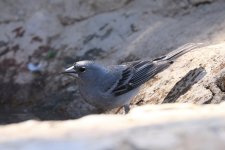 111IMG_0089_Tenerife Blue Chaffinch_Tenerife_07-2022.JPG1.3 MB · Views: 45
111IMG_0089_Tenerife Blue Chaffinch_Tenerife_07-2022.JPG1.3 MB · Views: 45 -
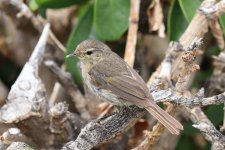 112IMG_9680_Canary Islands Chiffchaff_Tenerife_07-2022.JPG1.9 MB · Views: 40
112IMG_9680_Canary Islands Chiffchaff_Tenerife_07-2022.JPG1.9 MB · Views: 40 -
 113IMG_1183_Laurel Pigeon_Tenerife_07-2022.JPG347.8 KB · Views: 50
113IMG_1183_Laurel Pigeon_Tenerife_07-2022.JPG347.8 KB · Views: 50 -
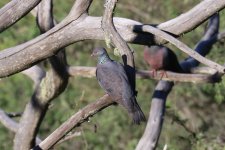 114IMG_0692_Bolle's Pigeon_Tenerife_07-2022.JPG658.9 KB · Views: 47
114IMG_0692_Bolle's Pigeon_Tenerife_07-2022.JPG658.9 KB · Views: 47 -
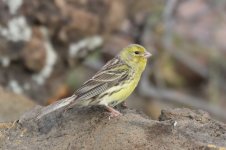 115IMG_1629_Atlantic Canary_Tenerife_07-2022.JPG494 KB · Views: 47
115IMG_1629_Atlantic Canary_Tenerife_07-2022.JPG494 KB · Views: 47 -
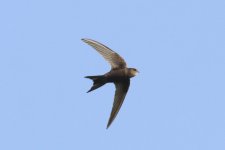 116IMG_2314_Plain Swift_Tenerife_07-2022.JPG281.5 KB · Views: 43
116IMG_2314_Plain Swift_Tenerife_07-2022.JPG281.5 KB · Views: 43 -
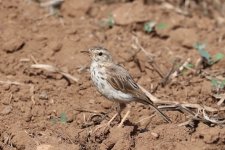 117IMG_1537_Berthelot's Pipit_Tenerife_07-2022.JPG1,014.4 KB · Views: 44
117IMG_1537_Berthelot's Pipit_Tenerife_07-2022.JPG1,014.4 KB · Views: 44 -
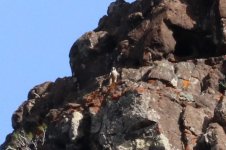 119IMG_0820_Peregrine Falcon (Barbary)_Tenerife_07-2022.JPG122.9 KB · Views: 45
119IMG_0820_Peregrine Falcon (Barbary)_Tenerife_07-2022.JPG122.9 KB · Views: 45 -
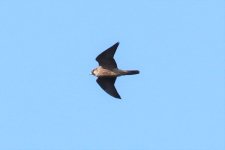 118IMG_1466_Peregrine Falcon (Barbary)_Tenerife_07-2022.JPG77.3 KB · Views: 43
118IMG_1466_Peregrine Falcon (Barbary)_Tenerife_07-2022.JPG77.3 KB · Views: 43





